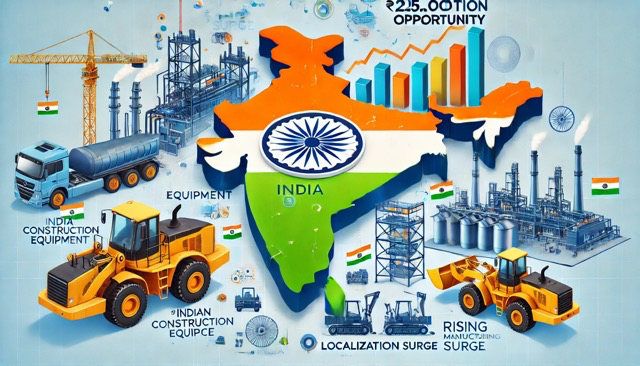Localization Boom in Indian Construction Equipment Sector Poised to Unlock ₹25,000 Crore Windfall
Published: 8.27.2024
The Indian construction equipment sector is on the cusp of a significant transformation, fueled by a powerful drive towards localization. As the government intensifies its focus on self-reliance and infrastructure expansion, industry experts forecast that this shift could unlock a lucrative ₹25,000 crore opportunity for domestic manufacturers and suppliers. With localization at the forefront, the construction equipment industry is set to experience unprecedented growth, offering new avenues for economic advancement.

Localization, the strategic move to source and produce components domestically, has gained substantial momentum in India’s construction equipment sector. Spearheaded by the government’s ‘Make in India’ initiative and reinforced by Production Linked Incentive (PLI) schemes, localization is emerging as a cornerstone of the country’s industrial strategy. These initiatives aim to curtail dependency on imports, spur innovation, and create employment opportunities, thereby bolstering the Indian economy.
In the construction equipment domain, localization encompasses the domestic manufacturing of essential components like engines, hydraulic systems, and transmission parts. This shift not only slashes costs but also ensures the production of high-quality equipment tailored to the unique requirements of the Indian market.
The potential windfall from localization in the Indian construction equipment sector is immense. As India embarks on an infrastructure renaissance, marked by massive projects in urban development, highway construction, railways, and smart cities, the demand for construction equipment is skyrocketing. By ramping up the production of locally sourced components, the industry is poised to tap into a ₹25,000 crore opportunity over the next few years.
This growth trajectory is expected to benefit a broad spectrum of stakeholders within the construction equipment ecosystem. From small and medium enterprises (SMEs) to large corporations, the entire supply chain stands to gain as localization efforts accelerate, creating a ripple effect of business opportunities across the industry.
The push towards localization offers numerous advantages for India’s construction equipment sector. First and foremost, it enhances the competitiveness of domestic manufacturers by reducing production costs and streamlining supply chain operations. Local sourcing of components also mitigates risks associated with global supply chain disruptions, as witnessed during the COVID-19 pandemic.
Moreover, localization drives the development of a skilled workforce, as manufacturers invest in training and upskilling their employees to meet the demands of advanced manufacturing processes. This focus on human capital boosts productivity and fosters innovation, further strengthening the industry’s global standing.
Additionally, localization aligns with India’s sustainable development goals. By minimizing the carbon footprint linked to long-distance transportation of components, the industry can contribute to the country’s environmental objectives while simultaneously driving economic growth.
The future of the Indian construction equipment sector is brimming with potential, with localization set to be a key catalyst for growth. To capitalize on this shift, industry stakeholders must continue to invest in research and development, adopt cutting-edge manufacturing technologies, and reinforce their supply chains.
Collaboration between government bodies, industry associations, and private enterprises will be vital in ensuring the success of localization initiatives. By fostering such partnerships, the industry can unlock the ₹25,000 crore opportunity, positioning India as a global leader in construction equipment manufacturing.
The surge in localization within the Indian construction equipment sector presents a transformative opportunity for the industry. With the right policies, investments, and collaborative efforts, this shift promises not only significant financial gains but also a more resilient, competitive, and sustainable future for India’s construction equipment sector.
Recent News

11.21.2024

11.20.2024



.png)